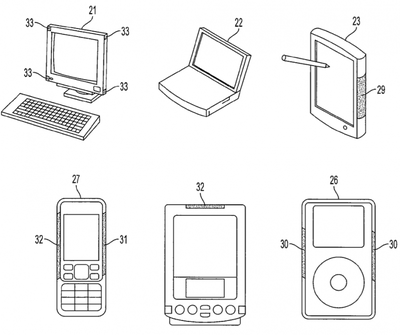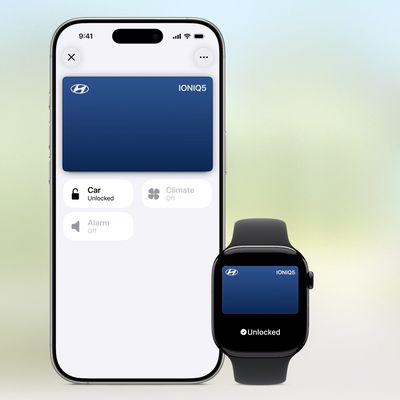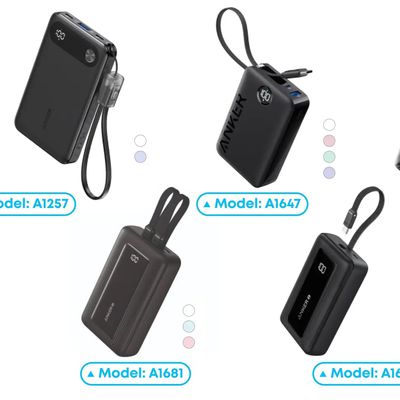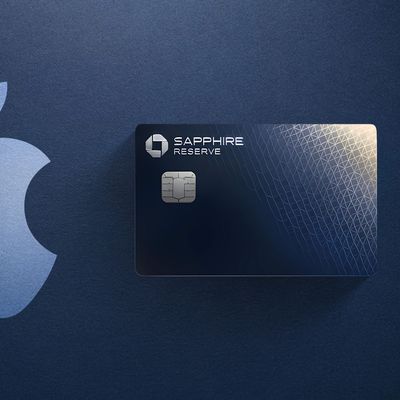Apple Wins Patent for Pressure-Sensitive Device Casings
Apple was today granted a 2009 patent application to allow users to control a device by pressing on, or squeezing, parts of the casing. An illustration in the patent shows potential touch-sensitive areas across a whole range of different devices:

The patent, discovered by AppleInsider, combines two different methods of detecting and measuring the amount of pressure applied: one physical, the other electrical. The capacitance test, which works in a similar way to touchscreens, would enable the device to tell human touch apart from accidental pressure applied while the device was carried in a pocket or bag.
Sensors disposed within the housing, in some embodiments directly beneath the surface, can detect when deflection occurs, which in turn denotes stress or pressure. In some embodiments, the sensors are connected to a printed circuit board that can in turn illuminate a light or other indicator when a minimum amount of readable stress is applied … A processor can take the measurements with their corresponding deflection rates, and translate them into device actions. For example, a threshold stress level is reached when a user presses down on a certain area of a device's housing. The processor determines that the capacitance change is outside the bounds of normal readings and can trigger a UI event or other device feature in response. The system can be customized to detect patterns and varied sensitivities to support a broad range of tasks.
Apple patents a great many technologies it never uses, either as potential solutions that are later rejected or to protect against competitor use, although the metal casing of the iPhone 5 could make the system practical on any future iPhone models with a similar casing.
Popular Stories
Apple's next-generation iPhone 17 Pro and iPhone 17 Pro Max are less than three months away, and there are plenty of rumors about the devices.
Apple is expected to launch the iPhone 17, iPhone 17 Air, iPhone 17 Pro, and iPhone 17 Pro Max in September this year.
Below, we recap key changes rumored for the iPhone 17 Pro models:Aluminum frame: iPhone 17 Pro models are rumored to have an...
Apple is developing a MacBook with the A18 Pro chip, according to findings in backend code uncovered by MacRumors.
Earlier today, Apple analyst Ming-Chi Kuo reported that Apple is planning to launch a low-cost MacBook powered by an iPhone chip. The machine is expected to feature a 13-inch display, the A18 Pro chip, and color options that include silver, blue, pink, and yellow.
MacRumors...
In 2020, Apple added a digital car key feature to its Wallet app, allowing users to lock, unlock, and start a compatible vehicle with an iPhone or Apple Watch. The feature is currently offered by select automakers, including Audi, BMW, Hyundai, Kia, Genesis, Mercedes-Benz, Volvo, and a handful of others, and it is set to expand further.
During its WWDC 2025 keynote, Apple said that 13...
Apple hasn't updated the AirPods Pro since 2022, and the earbuds are due for a refresh. We're counting on a new model this year, and we've seen several hints of new AirPods tucked away in Apple's code. Rumors suggest that Apple has some exciting new features planned that will make it worthwhile to upgrade to the latest model.
Subscribe to the MacRumors YouTube channel for more videos.
Heal...
Apple is planning to launch a low-cost MacBook powered by an iPhone chip, according to Apple analyst Ming-Chi Kuo.
In an article published on X, Kuo explained that the device will feature a 13-inch display and the A18 Pro chip, making it the first Mac powered by an iPhone chip. The A18 Pro chip debuted in the iPhone 16 Pro last year. To date, all Apple silicon Macs have contained M-series...
Popular accessory maker Anker this month launched two separate recalls for its power banks, some of which may be a fire risk.
The first recall affects Anker PowerCore 10000 Power Banks sold between June 1, 2016 and December 31, 2022 in the United States. Anker says that these power banks have a "potential issue" with the battery inside, which can lead to overheating, melting of plastic...
Chase this week announced a series of new perks for its premium Sapphire Reserve credit card, and one of them is for a pair of Apple services.
Specifically, the credit card now offers complimentary annual subscriptions to Apple TV+ and Apple Music, a value of up to $250 per year.
If you are already paying for Apple TV+ and/or Apple Music directly through Apple, those subscriptions will...
As part of its 10-year celebrations of Apple Music, Apple today released an all-new personalized playlist that collates your entire listening history.
The playlist, called "Replay All Time," expands on Apple Music's existing Replay features. Previously, users could only see their top songs for each individual calendar year that they've been subscribed to Apple Music, but now, Replay All...






















